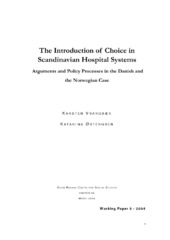| dc.contributor.author | Vrangbæk, Karsten | eng |
| dc.contributor.author | Østergren, Katarina | eng |
| dc.date.accessioned | 2006-06-21T14:13:32Z | |
| dc.date.accessioned | 2020-12-10T06:33:35Z | |
| dc.date.available | 2006-06-21T14:13:32Z | |
| dc.date.available | 2020-12-10T06:33:35Z | |
| dc.date.issued | 2004-03 | eng |
| dc.identifier.issn | 1503-0946 | |
| dc.identifier.uri | https://hdl.handle.net/1956/1377 | |
| dc.description.abstract | This paper describes a comparative study between free choice of hospital in Denmark and Norway. The starting point for the study is that the Scandinavian health care system has historically been dominated by a decentralized welfare state tradition. There has been a strong emphasis on equity and regional democratic control through the county institutions. To introduce free choice of hospital in this type of system is a challenge for a number of existing perceptions, structures and procedures in the Scandinavian system. From a system level perspective the planning capacity and the strong link between a given regional population and chosen level of public service are weakened. From a user perspective the relationship between the individual citizen and the health care system changes in the sense that patients become more empowered, when they can choose hospital. With this starting point the paper present an analysis of the arguments and the policy process for introducing free choice in the two countries. The analysis is made from two theoretical perspectives. First, from a rational perspective and second from a garbage can perspective. The results of the study show that even if there are large similarities between the two countries there are also large differences. That concerns timing, rhetoric and content of legislation. The explanation to the differences can help us to understand who it was possible to introduce free choice of hospital in the two countries. In Denmark it was possible because of the general consensus on the fashionable idea of choice that opened a political window for action. While in the Norwegian case it was possible because the government wanted to put pressure on the health sector in order to create better planning and use of resources. In Denmark the initial implementation of choice was adjusted to the dominant policy objectives of macroeconomic control through regional planning, while in Norway the chosen solution reflects a more limited concern for expenditure control and a greater willingness to experiment. | en_US |
| dc.description.abstract | Notatet er en beskrivelse av en sammenlignende studie av fritt sykehusvalg i Danmark og Norge. Utgangspunktet for studien er at det skandinaviske helsesystemet tidligere har vært dominert av et desentralisert velferdssystem. Det har vært et sterkt fokus på likhet og regional demokratisk kontroll. Å introdusere fritt valg av sykehus i den typen system er utfordrende for eksisterende forestillinger, strukturer og prosedyrer i et skandinavisk system. Fra et systemnivåperspektiv er planleggingskapasiteten og den sterke linken mellom den lokale befolkningen og politikerne svekket. Fra et brukerperspektiv er relasjonen mellom individet og helsesystemet endret i bemerkelsen at pasientene har fått større innflytelse gjennom at de kan velge sykehus. Med dette utgangspunktet presenteres en analyse av begrunnelsen og policyprosessen for innføring av fritt sykehusvalg i de to landene. Analysen gjøres fra to teoretiske perspektiver, dels fra et rasjonelt perspektiv og dels fra et garbage can perspektiv. Resultatet fra studien viser at det til tross for store likheter mellom de to landene også finnes store ulikheter. Det gjelder timing, retorikk og innhold i lovgivning. Forklaringen til forskjellene hjelper oss å forstå hvordan det ble mulig å få gjennomslag for å introdusere fritt sykehus valg. I Danmark ble det mulig gjennom at NPM-ideene var veldig populære da innføringen var aktuell i Danmark, mens det i det norske caset mer handler om å sette press på helsesektoren for å skape bedre plannlegging og ressursutnyttelse. I Danmark ble tilretteleggingen for fritt sykehusvalg i utgangspunktet tilpasset de dominerende policy-mål om makroøkonomisk kontroll og regional planlegging. Policy design og implementering ble derfor mindre vidtgående enn retorikken, mens det i Norge har blitt mer tilrettelagt for et reelt valg, og hensynet til makroøkonomisk kontroll og regional planlegging har vært mindre. | no |
| dc.format.extent | 457149 bytes | eng |
| dc.format.mimetype | application/pdf | eng |
| dc.language.iso | eng | eng |
| dc.publisher | Stein Rokkan Centre for Social Studies | eng |
| dc.relation.ispartofseries | 5-2004 | |
| dc.relation.ispartofseries | Working Paper | en |
| dc.title | The Introduction of Choice in Scandinavian Hospital Systems. Arguments and Policy Processes in the Danish and the Norwegian Case | eng |
| dc.type | Working paper | eng |
| dc.subject.nsi | VDP::Samfunnsvitenskap: 200 | nob |
